
Inflation, it has been said, comes as a thief in the night, and that it has. The famed British economist John Maynard Keynes warned of the dangers impressed upon an economy by inflation in his 1919 classic, The Economic Consequences of Peace. “Lenin was certainly right,” he wrote. “There is no subtler, no surer means of overturning the existing basis of society than to debauch the currency. The process engages all the hidden forces of economic law on the side of destruction, and does it in a manner which not one man in a million is able to diagnose.” Now we are suddenly faced with what could very well go down in history as the great financial shock of 2022 – an inflation rate approaching double digits in just a few short months and a steady stream of headlines that serve as a constant reminder of why we own gold.
“The nature of inflation is widely misunderstood and misinterpreted,” writes former Wall Streeter Dave Kranzler in an analysis posted at Investing.com. “‘Inflation’ and ‘currency devaluation’ are tautological — they are two phrases that mean the same thing.…Dollar devaluation has been occurring since the early 1970s. The value of the dollar relative to gold (real money) has declined 98%. In 1971, $40,000 would buy a 4,000-square-foot home in a good suburb. Now it takes $700,000 on average to buy that same home. Price inflation is evidence of currency devaluation.”
Though the dollar has been in an uptrend against other currencies of late (recently hitting a twenty-year high), its purchasing power in terms of goods and services is in sharp decline – and that, in the end, is the real reason why gold is now in such high demand. Kranzler says that the inflation wildfires are just getting started and to “hold onto gold and silver.” Similarly, veteran market analyst James Turk recently made some insightful comments during an Epoch Times interview on why gold has long served as a hedge against currency debasement.
“[Gold] does not suffer from entropy,” he said, “It cannot be destroyed. All the gold mined throughout history still exists in its aboveground stock, which if formed in a cube could slide under the arches of the Eiffel Tower.…A gram of gold buys essentially the same amount of crude oil as it did in 1950. This result occurs because the aboveground stock of gold grows by approximately the same rate as world population, causing the supply and demand for gold to remain in balance with the supply and demand of the goods and services humanity needs. Nature provides everything humanity needs to advance, including money.”
Below, we offer two charts supporting the Kranzler/Turk argument. The first shows the performance of gold against the long-term decline of the dollar. The second shows the sharp acceleration in that decline over the last two years – a period during which the dollar has lost a stiff 8% of its purchasing power.
Gold and the purchasing power of the U.S. dollar
(Log scale, 1971-2021)
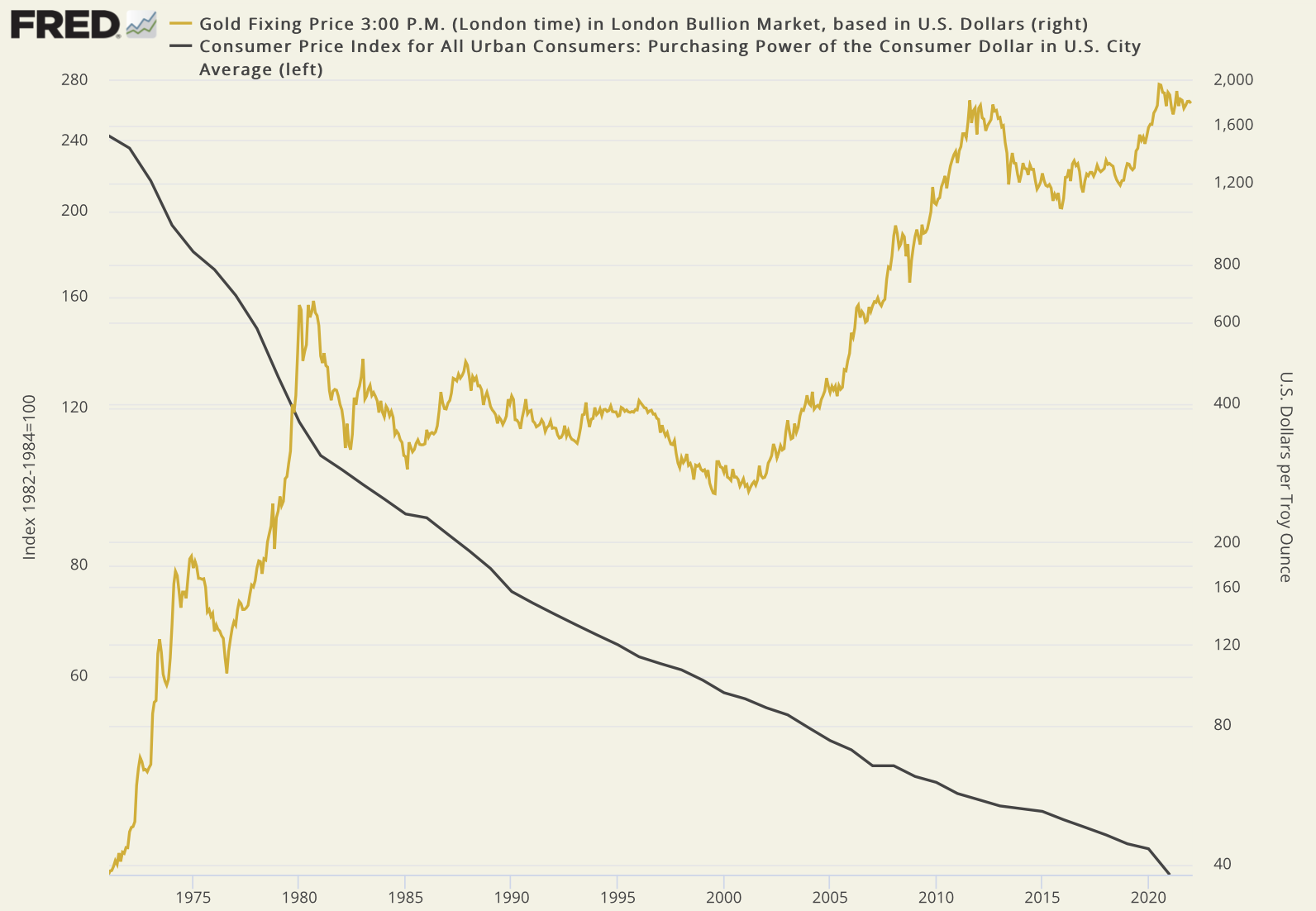
Purchasing power of the U.S. dollar
(2017 – April 2022)
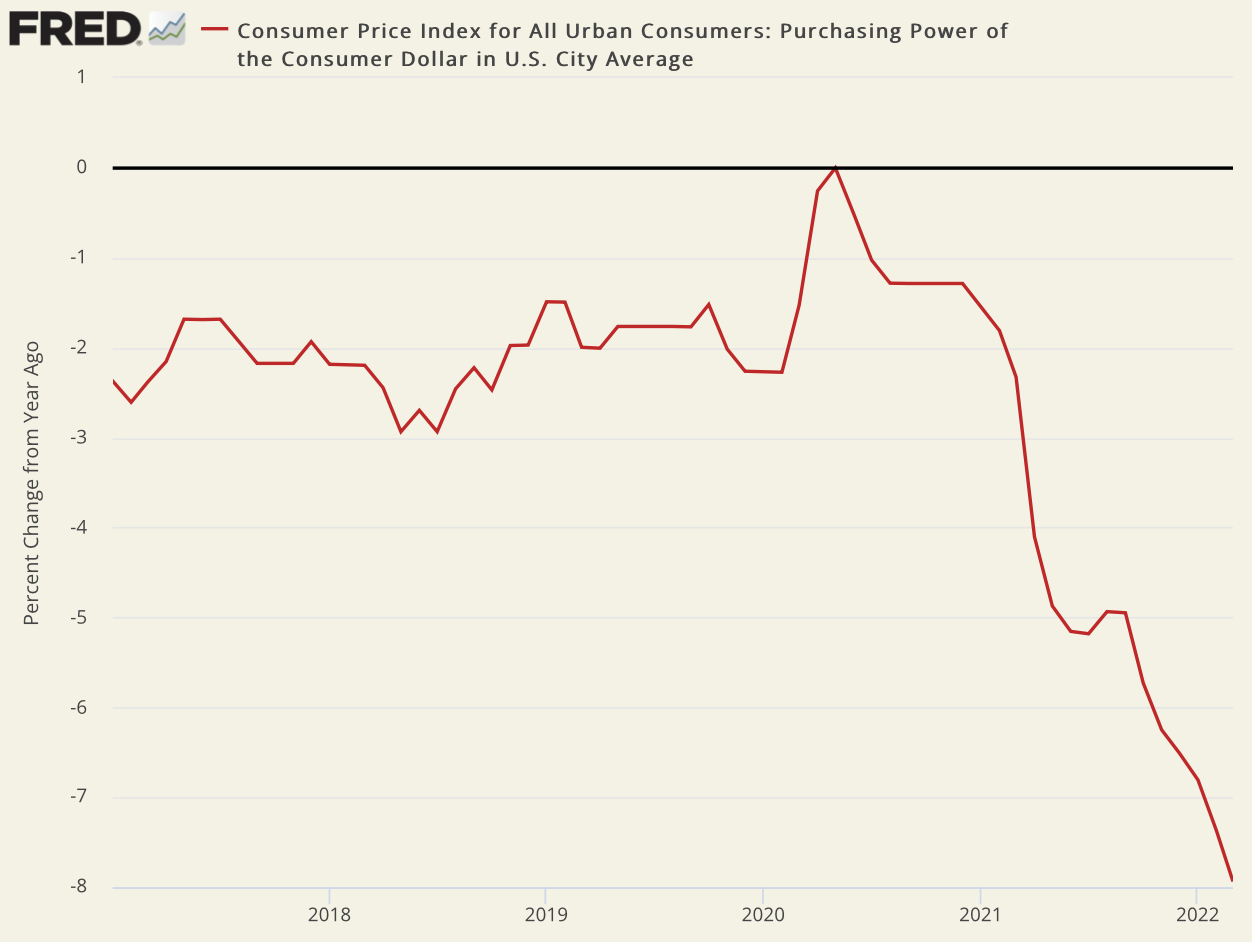
Sources: St. Louis Federal Reserve [FRED], U.S. Bureau of Labor Statistics
Short & Sweet
“THERE’S BEEN A LOT OF EXCITEMENT (if that’s the right word) over the idea that Russia is no longer accepting dollars as payment for its energy,” writes John Stepek in a recent Money Week piece. “Overall, it would prefer gold (‘hard currency’) or roubles, but it’ll take most other national currencies as long as they’re not greenbacks. Is this the beginning of the end for US dollar hegemony? The answer is ‘no.’” Stepek goes on from there to offer some very compelling arguments why the dollar is unlikely to be replaced anytime soon as the world’s primary reserve currency, the most salient of which is that no other currency can adequately serve as an alternative. At the same time, that argument, does not stand in the way of further debasement of the dollar. “You should certainly own some gold,” concludes Stepek. “It’s a solid disaster hedge, [and] it tends to do well when inflation surprises on the upside.…”
STARTING THIS YEAR, ISRAEL’S CENTRAL BANK will undergo a change of philosophy, reports YahooFinance. Its “currency mix will expand from the trio of the U.S. dollar, the euro, and the British pound to include the Canadian and Australian dollars as well as the yen and the yuan, which is also known as the renminbi. The additions mark a change in the Bank of Israel’s ‘whole investment guidelines and philosophy,’ Deputy Governor Andrew Abir said in an interview.” The decision raises an important question: Is this the shape of things to come for central banks charged with managing currency reserves? There is little doubt that Israel’s example will be taken seriously by other emerging country central banks. Some analysts have suggested that eventually, gold will come into play as central bank reserve diversification proceeds.
“[BIG SHORT INVESTOR MICHAEL] BURRY accused the US central bank of raising interest rates and shrinking its balance sheet not to combat inflation,” according to a recent Markets Insider report, “but to give itself room to pump up asset prices when they inevitably fall. ‘The Fed has no intention of fighting inflation,’ he tweeted. … ‘Serial half-point hikes are for getting elevation before stocks and the consumer tap out. Same with rapid-fire QT.’”
JUPITER ASSET MANAGEMENT’S NED NAYLOR LEYLAND thinks there will be a break out in the gold price and that “the trigger may be when inflation surprises to the upside or the market accepts that seven interest rate hikes in the US is a bit too aggressive.” He also believes that when the breakout occurs, silver will outperform gold and “very dramatically so.” “People are interested in gold because they are worried about future purchasing power,” he writes in an article posted at Gulf News. “The market is still considering whether the US Federal Reserve (Fed) will be able to raise interest rates as much as seven times this year and whether or not inflation will materially weaken. In my view, this is why gold hasn’t broken out properly yet — the market is focused on relatively hawkish observations.”

“THE FED HAS BEEN REASONABLY SUCCESSFUL in convincing markets that they have their eye on the ball,” says Plante Moran’s Jim Baird (CNBC – 4/10/2022), “and long-term inflation expectations have been held in check. As we look forward, that will continue to be the primary focus. It’s something that we’re watching very closely, to make sure that investors don’t lose faith in [the central bank’s] ability to keep a lid on long-term inflation.” At least for now, the Fed seems to have successfully lulled Wall Street into a false sense of security on what could become runaway inflation, but, as Baird suggests, that complacency could quickly turn to alarm.
DURING A TIME OF SECULAR CURRENCY DEBASEMENT, both stocks and bonds lose value simply on a purchasing-power basis if they do not keep up with or better inflation. “Where we are now,” says Man Group’s managing director Peter van Doojewert, “is a bit different. We’re in a universe of equities and bonds going down together. There’s a lot of instability. That instability is disconcerting. If they’re both going down, I need to find things that don’t behave like bonds and equities, which means commodities.”Bonds, at present, are in particularly dire straits losing both principal and purchasing power at the same time. In a separate study posted last June, Man Group lists gold and silver as two assets to which investors fled during past inflation episodes and were rewarded with double-digit returns. The firm also suggests acting sooner rather than later. Man Group is the world’s second-largest hedge fund behind Bridgewater Associates (also an advocate of gold ownership).
SHARD CAPITAL’S BILL BLAIN IS CONVINCED that the markets are “significantly underestimating how the rollover from Ukraine consequences will hit the global economy.” In a recent analysis, he says that “the waves of tectonic economic instability unleashed by the Ukraine conflict have shocked and caught the global commentariat of politicians, central bankers, economists and investment analysts off guard. Inflation from agribusinesses, energy, and supply chains is spinning unchecked – and, like a nuclear reaction, they are triggering a host of follow up consequences. It feels a little bit Chernobyl – the reactor is going critical! Our cosy assumptions about how the interconnected, globalised economy was supposed to work are being rocked to the core.”
–––––––––––––––––––––––
The six keys to successful gold ownership
This eye-opening, in-depth introduction to precious metals ownership will help you avoid many of the pitfalls that befall first-time investors. Find out who invests in gold, what role gold plays in serious investors’ portfolios, and the when, where, why, and how of adding precious metals to your holdings. To end right, it is critical that you start right, and the six keys to successful gold ownership will point you in the right direction.
“IN TIMES OF INFLATION, REAL RATHER THAN NOMINAL VALUES grow far more important,” writes Bloomberg’s John Authers. “How well has a price or return delivered for you, after taking inflation into account? In markets, it’s real rates that most matter. But how exactly do you measure reality?” Authers verbalizes what a good many investors have been thinking. Is calculating the real rate of return – using “inflation expectations,” for example, rather than the inflation rate itself – an accurate measure of investment returns? The chart below shows the yawning gap between the headline inflation rate and the yield on 10-year Treasuries. The mainstream financial media often explain gold market sell-offs as a response to rising yields. In our view, it is quite the opposite. A considerable amount of gold demand comes from investors liquidating bonds and moving to gold as the last safe haven left standing in an increasingly inflationary environment.
10-year Treasury yield vs. the headline inflation rate
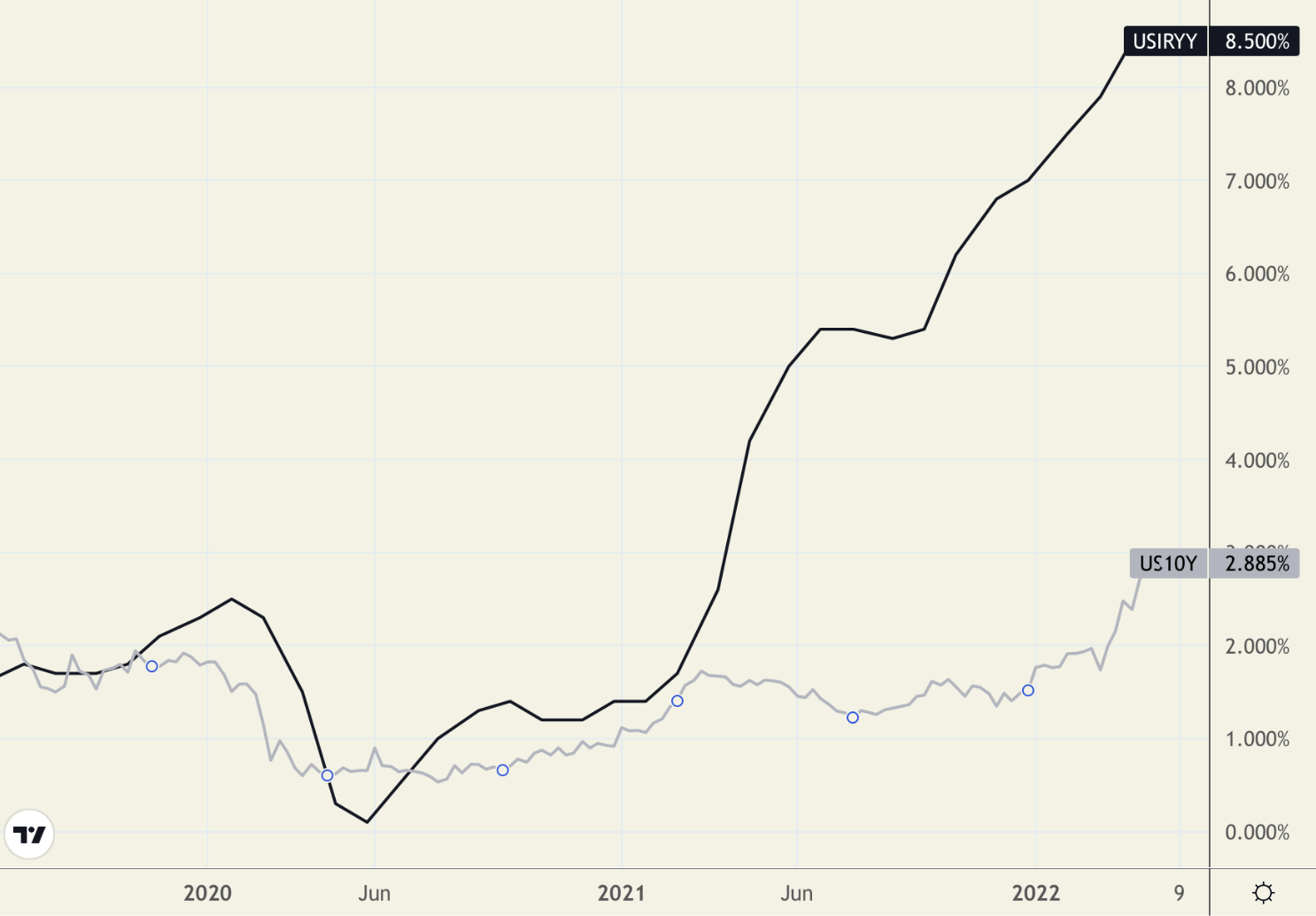
Chart courtesy of TradingView.com
MARKETWATCH’S MARK HULBERT RECENTLY WROTE an informative short commentary on the human propensity to force the randomness in markets into something seemingly more predictable, i.e., to “discover a pattern” as he puts it, “where none exists.” He observes that “all of us, when we’re investing or engaged in any other activity, have great difficulty truly contemplating randomness. We find patterns in random data even when we receive specific training on how to differentiate what is random and what is not.” The understanding that markets and the economy are random, in our view, is foundational to the rationale for gold and silver ownership.
Notable Quotable
“Contrary to much gold conspiracy thought, it does not mean that we are facing the demise of the Western banking system nor the rise of authoritarian economies and their fiat currencies. It doesn’t necessarily mean the rise of non-government backed intangible currencies either. Governments will maintain legal authority and power over currency systems. Individuals and businesses will use those currencies. The strongest fiat currencies are likely to continue to be those in advanced economies where the principles of liberty, justice, democracy, entrepreneurship, and free markets reign. The macro setup today portends a deleveraging of the global economy through inflation, including a probable step-function devaluation of all fiat currency systems relative to gold, a persistent phenomenon throughout world history.” – Crescat Capital, Seeking Alpha
“[I]s the Fed doing whatever it takes or is it just talking tough, while in reality implementing a weak initial response that could exacerbate the problem? We think it is clearly the latter. … [T]his feels like trying to figure out whether it’s best to clear a foot of snow from your driveway with a soup ladle vs. an ice cream scooper. This certainly isn’t doing whatever it takes.” – David Einhorn, Quarterly Market Review
“Do you see what I see? Do you see inflation in the West written all over this like I do? This crisis is not like anything we have seen since President Nixon took the U.S. dollar off gold in 1971 – the end of the era of commodity-based money. When this crisis (and war) is over, the U.S. dollar should be much weaker and, on the flipside, the renminbi much stronger, backed by a basket of commodities. From the Bretton Woods era backed by gold bullion, to Bretton Woods II backed by inside money (Treasuries with un-hedgeable confiscation risks), to Bretton Woods III backed by outside money (gold bullion and other commodities). After this war is over, ‘money’ will never be the same again…” – Zoltan Pozsar, Credit Suisse Economics
“The cities were still there, the houses not yet bombed and in ruins, but the victims were millions of people. They had lost their fortunes, their savings; they were dazed and inflation-shocked and did not understand how it had happened to them and who the foe was who had defeated them. Yet they had lost their self-assurance, their feeling that they themselves could be the masters of their own lives if only they worked hard enough; and lost, too, were the old values of morals, of ethics, of decency.” – Pearl S. Buck, novelist who was in Germany during the hyperinflation in 1923
 Cartoon courtesy of MichaelPRamirez.com
Cartoon courtesy of MichaelPRamirez.com
“There is a high probability that a self-perpetuating wage-price spiral will develop in the next few years. Households have already become less resistant to paying higher prices and firms have become less resistant to offering higher wages. Prices and wages will continue to spiral upward until the cumulative erosion in inflation-adjusted incomes causes the economy to collapse in recession.” – Richard Curtin, University of Michigan Consumer Sentiment Surveys
“Justified as they are, the sanctions imposed on Russia – one of the world’s largest exporters of metals and hydrocarbons — are wreaking havoc on already-strained commodities markets, with potentially dire consequences for the global economy. To avoid unnecessary damage, officials should be prepared to meet this extraordinary challenge with a no less extraordinary response: Emergency support from the U.S. Federal Reserve.” – Steven Kelly, Bloomberg Opinion
“As a species, we must make the jump to full sustainability. Decarbonizing our economy will be spectacularly resource intensive, and all key commodities required are finite in supply. Russia’s desperate attack on Ukraine makes everything more unpredictable but for one certainty – this war will increase the pressure on raw materials in the short term. It serves as a reminder more broadly that we will have to innovate around the bottlenecks, shortages, price spikes, and climate damage that are almost certainly coming our way so that we might survive to tell the tale.” – Jeremy Grantham, Seeking Alpha
It’s hard to know how much the U.S. Federal Reserve will need to do to get inflation under control. But one thing is certain: To be effective, it’ll have to inflict more losses on stock and bond investors than it has so far.” – Bill Dudley, former New York Fed president (as quoted in a MarketWatch article)
Final Thought
The Fed is keeping up with the Kardashians
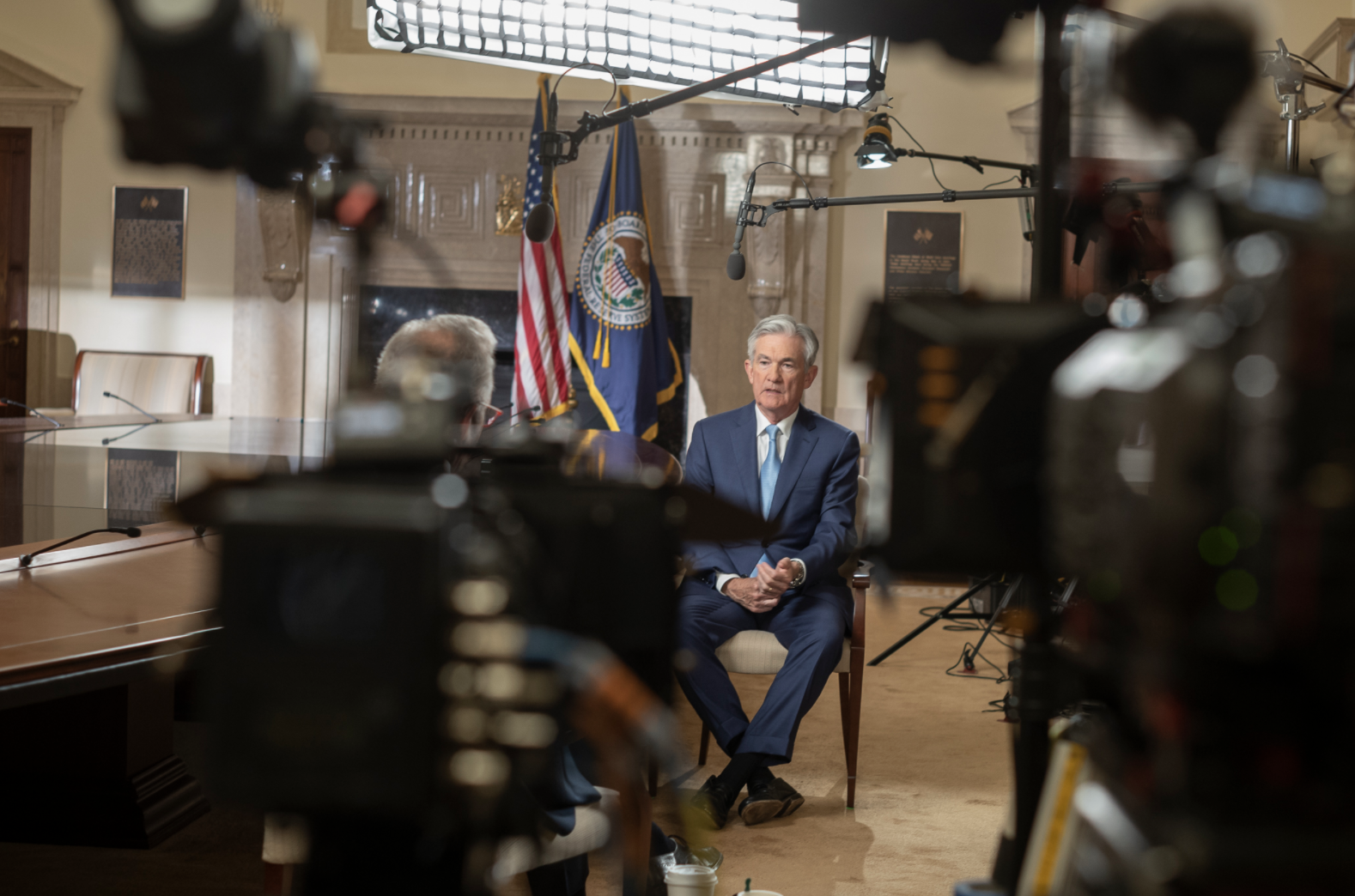
“As central bankers confront the most serious inflationary surge since Volcker’s time,” writes Gary Silverman in a Financial Times editorial, “they have become relentlessly chatty, appearing on stage and screen to discuss the latest economic data and the implications for the policymaking Federal Open Market Committee. The result is the Wall Street equivalent of Keeping Up with the Kardashians — must-see reality TV.” The problem with the high degree of “transparency” at the Fed is that neither Wall Street nor Main Street can fully put together what the barrage of information translates to. David Rosenberg, formerly an economist at Merrill Lynch, is quoted in Silverman’s editorial as saying that the Fed members who frequent the media speak not to Main Street but portfolio managers. The portfolio managers, in turn, often respond in a knee-jerk fashion pushing financial markets willy-nilly simply because they have the capital at their disposal to do so. The markets move accordingly, but not always in concert with reality. The comparison to the Kardashians is justified. We should learn to take these Fed-member public forays with a grain of salt and concentrate on what the Fed does, not what it says.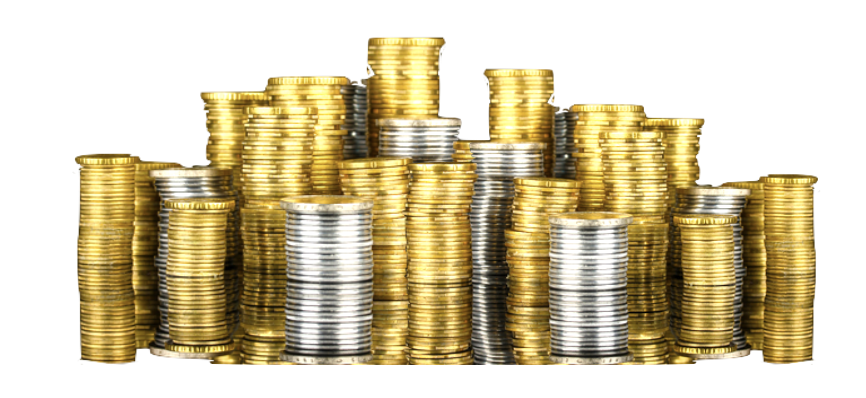 Are you looking to prepare your portfolio for whatever shocks might lie ahead?
Are you looking to prepare your portfolio for whatever shocks might lie ahead?
DISCOVER THE USAGOLD DIFFERENCE
1-800-869-5115 x100
orderdesk@usagold.com • • • Order gold & silver online 24-7

Michael J. Kosares is the founder of USAGOLD, author of The ABCs of Gold Investing – How To Protect and Build Your Wealth With Gold [Three Editions], and the firm’s publications editor.


